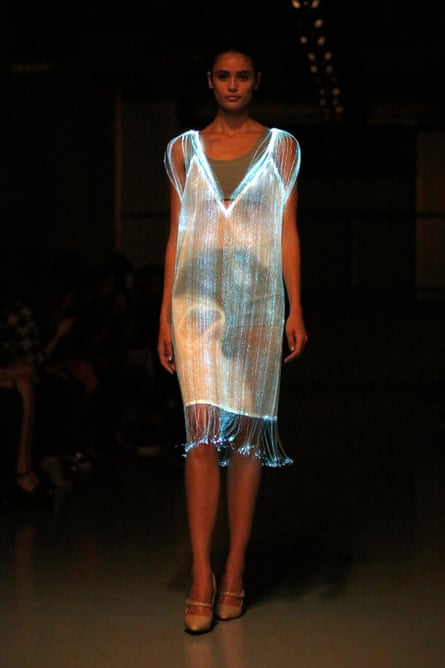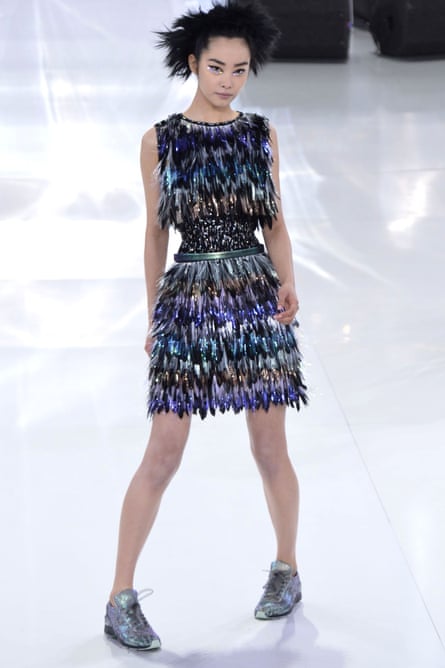Wearable tech should be sexy. What could be more thrilling than a skirt that twinkles with LEDs on the dancefloor, or a dress that transforms from midi to maxi at the touch of a button? How about a jacket with built-in wifi? Indeed, what could excite the fashion industry, driven by thirst for the new, any more?
Yet, when the topic is raised in fashion circles, eyes glaze over and yawns are stifled. The problem is not a lack of enthusiasm for tech, given that most editors, buyers and designers are iPhone virtuosos, spending the year running around fashion shows, glued to Instagram. What is not adding up is what wearable tech is and what it can do.
Hussein Chalayan was making spookily futuristic automated catwalk dresses as long ago as 2006; Richard Nicoll showed a breathtaking light up dress at London fashion week in September. But nothing that thrilling seems anywhere near point of sale. We have been hearing about T-shirts that monitor heart rate and muscle density, which make sense for sports fans but are not as compelling as beautifully-cut trousers for those who are into fashion.
Tory Burch has produced branded fitness tracker bands, but to the lay consumer the distinction between these and similar iPhone apps is not obvious. Opening Ceremony has launched varsity jackets with integrated phone chargers, but the advantage over putting a charging case on your phone seems negligible. So far, wearable tech seems to be a way for early adopters to experiment and be seen at the vanguard of innovation, rather than creating burning consumer desire. None of the big British fashion retailers are putting wearable tech at the centre of their buying strategies for spring/summer 2015.

The Apple Watch has piqued fashion’s interest, however, with the company wooing Anna Wintour and Karl Lagerfeld at Paris fashion week and the Watch appearing on the cover of Chinese Vogue. But whether the Watch is an outlier – and whether it is a true wearable or a smartphone that happens to be strapped on to one’s wrist – is debatable. Similarly, two small but intriguing product launches for 2015 – US designer Rebecca Minkoff’s bracelets that charge iPhones, on sale in February, and Ringly’s vibrating rings, which activate when your phone rings and launch in January, seem more like chic gadgets than true fashion.
Getting people “obsessed” – as the fashion industry would say – will require products with a useful, clear purpose that are aesthetically on point. There has been talk about whether women will wear bulky, masculine devices, and many of the resulting ideas – feminine, pastel-coloured trinkets – are at odds with trends towards functional wear and minimalism. The involvement of the industry’s most influential designers – the likes of Chanel, JW Anderson, Céline, Stella McCartney, Prada, and on the high street Topshop, Cos, Zara – would address this.

In January 2014, Lagerfeld sent Chanel’s couture models down the catwalk wearing trainers, bestowing fashion’s official blessing on flat shoes, and a million tills started ringing. Wearable tech needs such a watershed moment. You can bet design houses are quietly meeting experts, eager to ensure they are not left behind, but cautious about rushing out a product that flops.
In Britain, Burberry may well make the first move. The company is famed for technological innovation and has a dedicated “what if?” division exploring such areas. Still, 2015 feels a bit early for that turning point – unless someone in the industry has a closely guarded secret up their sleeve. In any case, with the Apple Watch a sure topic of conversation at the next round of fashion weeks in February, this will be the year fashion’s enthusiasm for wearable tech truly flourishes.
Hannah Marriott

Comments (…)
Sign in or create your Guardian account to join the discussion